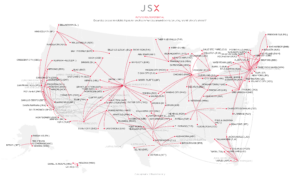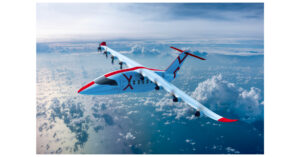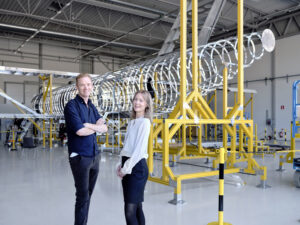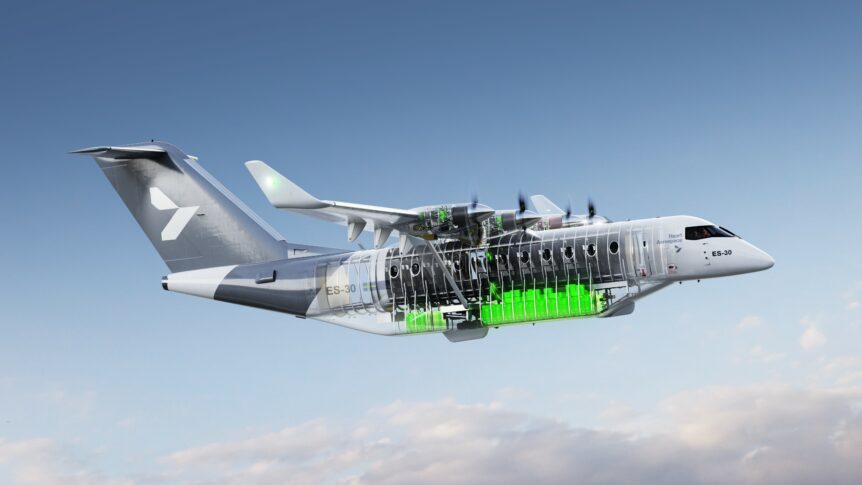JSX, an American semi-private airline, may very well shake up the travel world with plans to buy up to 330 electric and hybrid aircraft.
JSX (Jet Suite Executive) dispatches with some niceties of larger airlines, but also avoids long lines, TSA (Transport Safety Administration) baggage checks and shoe removal, and lengthy waits for mobs of passengers to stuff their bags in overhead compartments (there are none on their JSX Embraer 135s).
Instead, a passenger arrives at a JSX ticket office, sometimes situated in a hangar on the sometimes funky end of the airport, gets a boarding pass and self-serves some light refreshments. He or she walks out to the 30-passenger (maximum allowed) craft, climbs aboard and finds an assigned seat (either two abreast or single). Passengers can even bring a certified service animal into the cabin.
This type of aviation seems looser and more enabling than that of the big carriers. JSX is enjoying a lot of press and some favor, but still flies smaller, fossil-fuel-powered versions of what the big carriers operate. In a move that would gladden Greta Thunberg’s heart, JSX is planning on buying over 330 electric and hybrid craft and expanding its services.
Of course, all this is contingent on FAA certification and successful flight testing, but the prospective sellers seem to be on track to meet those challenges. Such an expansion of electric aviation would be a major public relations coup for clean aviation, and a sign that regional air commerce could find wide acceptance.
JSX sees itself in a major role in the new aviation economy. “Network airlines can serve around 480 airports in the United States, but JSX can serve over 2,000 and these hybrid-electric airplanes are versatile enough to be useable without big changes to massive infrastructure. That means a cost-effective flying option for small towns around the nation and low-emissions and low-noise planes for the planet. These are just a few of the thousands of route possibilities the hybrid-electric aircraft revolution allow JSX to make a reality.”

JSX plans a huge increase in airports served and routes flown – electrically
JSX has chosen three aircraft of varying sizes and ranges to augment its fleet, the grand total possible increasing its fleet from 48 135s to over 330 craft. JSX would need at least that many pilots and far more than its current 1,200 total employees. Alex Wilcox, JSX CEO and Co-Founder, understands the implications of the proposed moves. “As the network airlines order ever-larger aircraft it is inevitable that more and more small markets will be abandoned. Electra, Aura Aero, and Heart Aerospace are visionary organizations that share in JSX’s commitment to serving smaller communities, working together with us to weave sustainable regional air travel back into the fabric of American commerce and freedom of movement.”
This would be a further vindication of William T. Piper’s vision of small aircraft serving small communities. His Cubs and Cruisers would have even used grass strips common throughout America 70 years ago. JSX has a more modern approach to the same goals.
Electra eSTOL
Electra Aero’s nine-seat carrier could take off in as little as 150 feet, using large flaps, a small turbine-powered generator and eight electrically-driven propellers to allow Electra’s eSTOL aircraft to generate high lift at low airspeed and low drag at high speed.• Electra has received orders for up to 82 Electra craft (32 firm, with options for 50 more) from JSX.
This craft could provide true city-center to city center travel, able to take off and land in parking lots of from some root tops. Imagine landing at your destination rather than at a distant airport. Consider skipping the shoes-off inspection when boarding and the fight to retrieve one’s luggage after landing. Consider skipping the shuttle or cab ride to town and you see a small part of the charm of this type of travel.
Aura ERA
This 19 seat, eight motor French craft can take its passengers up to 1,000 miles in a stand-up, pressurized cabin. The ERA (Electric Regional Aircraft) matches the range of most airline trips, which average around 800 miles. Its all-electric takeoff from an 800-meter (2.625 feet) runway will make it a good neighbor in neighborhoods close to town centers.

with long-range capabilities, Aura craft will make up to 1,000 mile trips
Aelis’ Group, overseeing development of business opportunities for Aura, promotes itself as, “The regional and electric aircraft expert. Solutions to decarbonize aviation.” CEO Philippe Lienard reflects on the value of the ERA. “The 19-seater is the starting point in the regional market. We are developing a pressurized aircraft with a normal turboprop speed at 250 knots at 25,000 feet with short-take-off capability at 800 meters.” He notes the economy of operation. “A conventional engine goes to a shop as a performance restoration, but the ERA 19-seater will improve its performance with time. The residual value of an aircraft is core to an investor.”
With operating costs of 0.10 Euro per passenger kilometer (about 17.6 cents per passenger mile), operators can add to their own bottom line and even pass such savings on to customers. That would cost $140 for the average 800 mile trip. This should increase demand for such services.
Heart Aerospace ES-30
A 30 seat machine manufactured in Sweden can manage 200 kilometers (124 miles) in all electric mode with current batteries, 400 kilometers (248 miles in electric plus hybrid mode, and up to 800 kilometers (496 miles) in electric plus hybrid mode carrying only 25 passengers. It can operate from an 1,100 meter (3,600 feet) runway. At maximum take-off weight (MTOW) an Embraer 135 requires a 1,640 meter (5,351 feet) runway. This allows a greater choice of airports from which the hybrid craft can operate.
JSX explains, “These hybrid electric marvels from Sweden most closely mirror our current existing fleet with 30 roomy seats on every aircraft. Offering not just unmatched efficiency and speed, but a resounding commitment to environmental sustainability, our order for the Heart Aerospace ES-30 will allow for low-emissions, low-noise operations all over the country.” To that end, JSX is proposing up to 100 orders, with 50 firm and fifty as options.

Anders Forslund and Klara Forslund, founders Heart Aerospace (Photographer: Patrik Olsson) Propulsion
All three aircraft will benefit from coming changes, with longer ranges as batteries evolve. Climate change may increase demand for low- and zero-emission craft. Increased population density may add to demands for lower-noise aircraft. As fuel costs rise, electricity prices may decrease, adding to the profitability of green aircraft. Even maintenance charges will see a greater disparity between conventional and electric aircraft.
All this indicates a rosier future for the electric and hybrid aircraft market.

